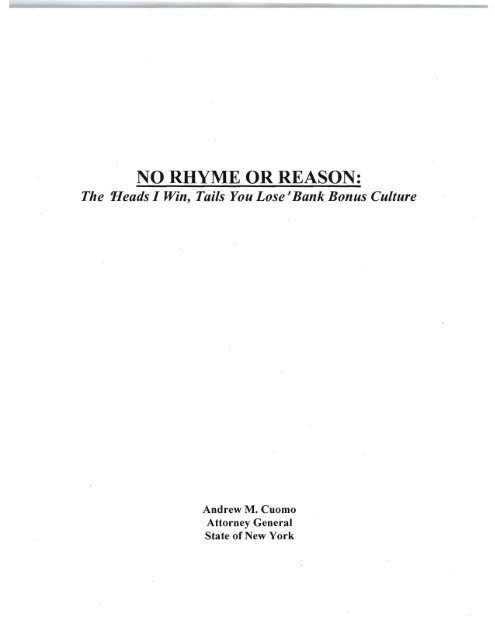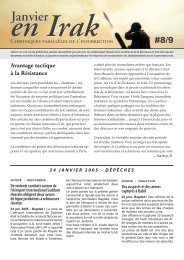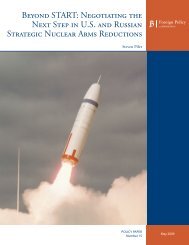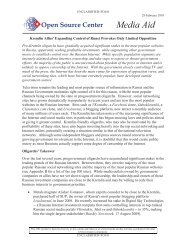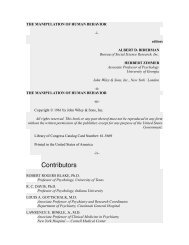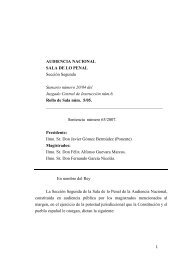No Rhyme or Reason: The 'Heads I Win, Tails You Lose' Bank ...
No Rhyme or Reason: The 'Heads I Win, Tails You Lose' Bank ...
No Rhyme or Reason: The 'Heads I Win, Tails You Lose' Bank ...
Create successful ePaper yourself
Turn your PDF publications into a flip-book with our unique Google optimized e-Paper software.
NO RHYME OR REASON:<br />
<strong>The</strong> 11eads I <strong>Win</strong>, <strong>Tails</strong> <strong>You</strong> Lose I <strong>Bank</strong> Bonus Culture<br />
Andrew M. Cuomo<br />
Att<strong>or</strong>ney General<br />
State of New Y<strong>or</strong>k
NO RHYME OR REASON:<br />
<strong>The</strong> Heads I <strong>Win</strong>, <strong>Tails</strong> <strong>You</strong> Lose I <strong>Bank</strong> Bonus Culture<br />
Through various inquiries, the New Y<strong>or</strong>k State Att<strong>or</strong>ney General's Office has been examining the<br />
causes oflast year's economic downturn. We have reviewed the failures of the credit rating<br />
agencies, the role of government regulat<strong>or</strong>s, the flaws of the credit default swap market, and the<br />
effects of over-leverage and fraud in the housing and m<strong>or</strong>tgage markets, among others.<br />
As part of this review we have also been examining the compensation structures employed by<br />
various banks and firms. Acc<strong>or</strong>dingly, over the past nine months this Office has been conducting<br />
an investigation into compensation practices in the American banking system. Wehave<br />
reviewed hist<strong>or</strong>ic and current data on numerous banks' compensation and bonus plans. We have<br />
taken testimony from participants in all aspects of,the process, including bank executives who set<br />
and administer the compensation process, members of boards of direct<strong>or</strong>s who review company<br />
salary and bonus structures, compensation consultants who advise the companies, and the<br />
recipients of bonuses.<br />
As one would expect, in describing their compensation programs, most banks emphasize the<br />
imp<strong>or</strong>tance of tying pay to perf<strong>or</strong>mance. Indeed, one seni<strong>or</strong> bank executive noted recently that<br />
individual compensation should hot be set without taking into strong consideration the<br />
perf<strong>or</strong>mance of the business unit and the overall firm. As this executive put it, "employees<br />
should share in the upside when overall perf<strong>or</strong>mance is strong and they should all share in the<br />
downside when overall perf<strong>or</strong>mance is weak."<br />
But despite such claims, one thing is clear from this investigation to date: there is no clear rhyme<br />
<strong>or</strong> reason to the way banks compensate and reward their employ~es. In many ways, the past three<br />
years have provided a virtual lab<strong>or</strong>at<strong>or</strong>y in which to test the hypothesis that compensation in the<br />
financial industry was perf<strong>or</strong>mance-based. But even a curs<strong>or</strong>y examination of the data suggests<br />
that in these challenging economic times, compensation f<strong>or</strong> bank employees has become<br />
unmo<strong>or</strong>ed from the banks' financial perf<strong>or</strong>mance.<br />
Thus, when the banks did well, their employees were paid well. When the banks did po<strong>or</strong>ly,<br />
their employees were paid well. And when the banks did very po<strong>or</strong>ly, they were bailed out by<br />
taxpayers and their employees were still paid well. Bonuses and overall compensation did not<br />
vary significantly as profits diminished.<br />
An analysis of the 2008 bonuses and earnings at the <strong>or</strong>iginal nine TARP recipients illustrates the<br />
point. Two firms, Citigroup and Merrill Lynch suffered massive losses of m<strong>or</strong>e than $27 billion<br />
ateach firm. Nevertheless, Citigroup paid out $5.33 billion in bonuses and Merrill paid $3.6<br />
billion in bonuses. Together, they lost $54 billion, paid out nearly $9 billion in bonuses and then<br />
received TA~ bailouts totaling $55 billion.
F<strong>or</strong> three other firms - Goldman 8achs, M<strong>or</strong>gan Stanley, and JP. M<strong>or</strong>gan Chase - 2008 bonus<br />
payments were s'ubstantially greater than the banks' net income. Goldman earned $2.3 biHion,<br />
paid out $4.8 billion in bonuses, and received $10 billion in TARP funding. M<strong>or</strong>gan Stanley<br />
earned $1.7 billion, paid $4.475 billion in bonuses, and received $10 billion in TARP funding.<br />
JP. M<strong>or</strong>gan Chase earned $5.6 billion, paid $8.69 bil1ion in bonuses, and received $25 billion in<br />
TARP funding. Combined, these three firms earned $9.6 billion, paid bonuses of nearly $18<br />
billion, and received TARP taxpayer funds w<strong>or</strong>th $45 bil1ion. Appendices A and B, attached<br />
hereto, provide further inf<strong>or</strong>mation on the 2008 earnings, bonus pools, and TARP funding f<strong>or</strong> the<br />
nine <strong>or</strong>iginal TARP recipients. We note that some of the nine recipients maintain that they did<br />
not request <strong>or</strong> desire TARP funding.<br />
Other banks, like State Street and <strong>Bank</strong> ofNew Y<strong>or</strong>k Menon, paid bonuses that were m<strong>or</strong>e in<br />
line with their net income, which is certainly what one would expect in a difficult year like 2008;<br />
F<strong>or</strong> example, State Street earned $1.8 billion, paid bonuses totaling approximately $470 million,<br />
and received $2 billion in TARP funding. Thus, the relationship between perf<strong>or</strong>mance of the<br />
firms and bonuses varied immensely and the bonus incentive system does not appear to have<br />
been tethered to any consistent principles tying compensation to perf<strong>or</strong>mance <strong>or</strong> risk metrics.<br />
Hist<strong>or</strong>ical financial filings supp<strong>or</strong>t the same conclusions. At many banks, f<strong>or</strong> example,<br />
compensation and benefits steadily increased during the bull market years between 2003 and<br />
2006. However, when the sub-prime crisis emerged in 2007, followed by the current recession,<br />
compensation and benefits stayed at bull-market levels even though bank perf<strong>or</strong>mance<br />
plummeted. F<strong>or</strong> instance, at <strong>Bank</strong> of America, compensation and benefit payments increased<br />
from m<strong>or</strong>e than $10 billion to m<strong>or</strong>e than $18 billion in between 2003 and 2006. Yet, in 2008,<br />
when <strong>Bank</strong> of America's net income fell from $14 billion to $4 billion, <strong>Bank</strong> of America's<br />
compensation payments remained at the $18 billion level. <strong>Bank</strong> of America paid $18 billion in<br />
compensation and benefit payments again in 2008, even though 2008 perf<strong>or</strong>mance was dismal<br />
when compared to the 2003-2006 bull market. Similar patterns are clear at Citigroup, where<br />
bull-market compensation payments increased from $20 billion to $30 billion. When the<br />
recession hit in 2007, Citigroup's compensation payouts remained at bull-market levels - wellover<br />
$30 billion, even though the firm faced a significant financial crisis. Appendix C, attached<br />
hereto, provides further hist<strong>or</strong>ical data.<br />
In some senses, large payouts became a cultural expectation at banks and a source of competition<br />
among the firms. F<strong>or</strong> example, as Merrill Lynch's perf<strong>or</strong>mance plummeted, Merrill severed the<br />
tie between paying based on perf<strong>or</strong>mance and set its bonus pool based on what it expected its<br />
competit<strong>or</strong>s would do. Acc<strong>or</strong>dingly, Merrill paid out close to $16 billion in 2007 while losing<br />
m<strong>or</strong>e than $7 billion and paid close to $15 billion in 2008 while facing near collapse. M<strong>or</strong>eover,<br />
Merrill's losses in 2007 and 2008 m<strong>or</strong>e than erased Merrill's earnings between 2003 and 2006.<br />
Clearly, the compensation structures in the boom years did not account f<strong>or</strong> long-term risk, and<br />
huge paydays continued while the firm faced extinction.<br />
Thus, rather than abiding by steady principles to guide compensation decisions year in and year<br />
out, bank executives did just the opposite by delivering high compensation every year. F<strong>or</strong><br />
2
example, testimony from the head of Merrill Lynch's compensation committee revealed that in<br />
2007, Merrill changed its compensation rationale resulting in huge bonuses in it difficult year:<br />
Q: In 2008 was Merrill Lynch looking at the bonuses as a percent of revenue<br />
A: <strong>No</strong>. In 2007 we diverted from that f<strong>or</strong> reasons. We set out in a proxy that Merrill had<br />
suffered substantial losses largely related to one unit of the c<strong>or</strong>p<strong>or</strong>ation. Overall financial<br />
perf<strong>or</strong>mance is usually a key ingredient. We had to balance that with the need to pay our<br />
employees in units that perf<strong>or</strong>med....<br />
Q: Did there come a time in 2008 when you revisited that approach that you need to consider<br />
having bonuses in some way reflect the economic perf<strong>or</strong>mance of Merrill year to date<br />
A: I think we always looked at financial perf<strong>or</strong>mance, but [beginning in 2007] I think we<br />
thought it would jeopardize the long-term health of the firm - and certainly later jeopardize the<br />
franchise value of <strong>Bank</strong> of America - if we didn't pay people who perf<strong>or</strong>med and contributed f<strong>or</strong><br />
their perf<strong>or</strong>mance in the face oflarge losses on legacy assets in some units....] .<br />
<strong>The</strong> inf<strong>or</strong>mation contained in the three appendices attached hereto set out, in stark terms, the<br />
failure of the compensation structures at many of our nation's largest financial institutions to<br />
follow any objective and consistent principles. To the contrary, what these statistics p<strong>or</strong>tray is an<br />
ad hoc system that does not come dose to meeting the goal of having employees share in the<br />
upside and the downside of their firm's perf<strong>or</strong>mance. We emphasize that the problems we have<br />
found relate to problems with banking compensation system-wide and should not be taken as<br />
criticism of any particular individual's conduct.<br />
We recognize, of course, that there can be situations where the distribution of profits to<br />
employees who created real profits would be appropriate even though the overall firm may have<br />
lost money. This might be the case, f<strong>or</strong> example, where one division of a firm earned large<br />
profits but another division lost profits. A principled and consistent approach would, however,<br />
balance the need to reward and retain those who created profits with the need f<strong>or</strong> bonuses to<br />
reflect the overall perf<strong>or</strong>mance of the firm. In any event, our investigations have shown<br />
numerous instances where large bonuses were paid to individuals in money-losing divisions at<br />
firms who saw either substantially reduced profits <strong>or</strong> losses in 2008.<br />
In sum, as we seek to learn lessons from this economic crisis and repair the damage it has<br />
wrought, it will be vital to develop and implement sound principles and rationales f<strong>or</strong> executive<br />
compensation and bonuses that promote sustainable and rational economic growth. <strong>The</strong> repeated<br />
explanation from bank executives that bonuses are tied to perf<strong>or</strong>mance in a manner designed to<br />
promote such growth does not appear to be accurate. Indeed, our investigation suggests a<br />
disconnect between compensation and bank perf<strong>or</strong>mance that resulted in a "heads I win, tails you<br />
lose" bonus system. In other w<strong>or</strong>ds, bank compensation structures lacked consistent principles<br />
and tended to result in a compensation system that was all "upside."<br />
3
<strong>The</strong> private market place is, and should be responsible f<strong>or</strong> setting compensation structures.<br />
However, compensation packages should be designed to promote long-term, sustainable growth<br />
and actual increases in value. This would drive firms towards decision-making that promotes<br />
long-term actual growth and perf<strong>or</strong>mance rather than the dangerous combination of sh<strong>or</strong>t-term<br />
booked profits and blow-up deferral caused by the current bonus culture. M<strong>or</strong>eover, if market<br />
participants begin following sounder and m<strong>or</strong>e principled bonus systems, firms would be less<br />
susceptible to the "poaching" of their employees by other firms offering unreasonably large<br />
compensation packages. Such poaching has too often resulted in irrational bonus bidding wars<br />
that harm the entire industry by f<strong>or</strong>cing firms to continually increase bonus levels and leading to<br />
a compensation system that is simply a one-way ratchet up.<br />
This rationalization of the compensation and bonus system must be accomplished now.<br />
Hopefully, the private sect<strong>or</strong> sees the problem and addresses it quickly. <strong>The</strong> private sect<strong>or</strong> is the<br />
appropriate f<strong>or</strong>um f<strong>or</strong> such ref<strong>or</strong>m, and some firms have already taken steps in the right direction.<br />
If the private sect<strong>or</strong> does not act, such ref<strong>or</strong>m should be discussed as part of the federal<br />
regulat<strong>or</strong>y ref<strong>or</strong>m eff<strong>or</strong>t, and, where appropriate, taken into account by the Obama<br />
Administration's pay czar.<br />
\<br />
I<br />
4
APPENDIX A<br />
-,<br />
TARP RECIPIENTS' 2008 BONUS CHART<br />
Below is a chart of the <strong>or</strong>iginal nine TARP recipients f<strong>or</strong> 2008 highlighting each banks earnings/losses, bonus pool, number of<br />
employees, earnings per employee, bonus per employee, amount ofTARP funds received and the amount of bonus payments in excess<br />
of $3 million, $2 million and $1 million.<br />
:::$2<br />
M__:::~lM·<br />
<strong>Bank</strong> of America $4,000,000,000 $3,300,000,000 243)000 $16,461 $13,580 $45 B 28 65 172<br />
.. <strong>Bank</strong> of New Y<strong>or</strong>k Mellon $1,400,000,000 $945,000,000 42,900 $32,634 $22,028 $3 B 12 22 74<br />
Citigroup, Inc. ($27,700,000,000) $5,330,000,000 322,800 ($85,812) $16,512 $45 B 124 176 738<br />
Goldman Sachs Group $2,322,000,000 $4,823,358,763 30,067 $77,228 $160,420 $10 B 212 391 953<br />
,J.P. M<strong>or</strong>gan Chase & Co.. $5,600,000,000 $8,693,000, 000 224,961 $24,893 $38,642 $25 B >200 1,626<br />
-<br />
I,Merrill Lynch ($27,600,000,000) $3,600,000,000 59,000 ($467,797) $61,017 $10 B 1~9 696<br />
M<strong>or</strong>gan Stanley $1,707,000,000 $4,475,000,000 46,964 $36,347 $95,286 $10 B 101 189 428<br />
-<br />
'State Street C<strong>or</strong>p. $1,811,000,900 $469,970,000 2~.475 $63,600 $16,505 $2 B 3 8 44<br />
~Well§Fargo & Co:. _ $42,933,000,000) $977,500,000 281,000 ($152,786) $3,479 $25 B 7 22 62<br />
* Wells Fargo & Company's 2008 losses include Wachovia's 2008 losses.<br />
5
APPENDIX B<br />
TARP RECIPIENTS' 2008 COMPENSATION SUMMARY<br />
WITH BONUS BREAKDOWN<br />
Below is a summary of the <strong>or</strong>iginal nine TARP recipients highlighting the total amount of<br />
TARP funds received by each bank, the total 2008 earnings, the total 2008 bonuses, the number of<br />
employees receiving a bonus over a $1 mil1ion, the total number of employees and a breakdown of<br />
the bonus' payments.<br />
. 1. <strong>Bank</strong> of America<br />
TARP:<br />
$45 billion ($15 billion on 10/28/08 under the Capital Purchasing<br />
Program; $10 billion on 1/9/09 under the Capital Purchasing<br />
Program [f<strong>or</strong> Merrill Lynch]); $20 billion on 1/16/09 under the<br />
Targeted Investment Program (1/16/09 Treasury and other<br />
government <strong>or</strong>ganizations agrees to backstop $118 billion in<br />
assets)<br />
2008 Earnings: $4.0 billion, <strong>or</strong> $0.55 per diluted common share.<br />
2008 Total Bonuses: $3.33 billion in cash and equity ($2.9 billion of the mixed cash and<br />
equity bonuses were discretionary and $337 million of the mixed<br />
cash and equity bonuses were guaranteed)<br />
172 employees: at least $1 million<br />
Total W<strong>or</strong>kf<strong>or</strong>cel: 243,000<br />
BODUS Breakdown<br />
.<strong>The</strong> top four recipients received a combined $64.01 million.<br />
<strong>The</strong> next four bonus recipients received a combined $36.85 million.<br />
<strong>The</strong> next six bonus recipients received a combined $31.39 million.<br />
Four individuals received bonuses of $1 0 million <strong>or</strong> m<strong>or</strong>e and combined they received<br />
$64.01 million.<br />
8 individuals received bonuses of $8 million <strong>or</strong> m<strong>or</strong>e.<br />
1 All W<strong>or</strong>kf<strong>or</strong>ce numbers were taken from the companies' l(}K's f<strong>or</strong> the year 2008.<br />
6
10 individuals received bonuses of $5 million <strong>or</strong> m<strong>or</strong>e.<br />
28 individuals received bonuses of $3 million <strong>or</strong> m<strong>or</strong>e.<br />
65 individuals received bonuses of $2 million <strong>or</strong> m<strong>or</strong>e.<br />
Overall, the top 28 bonus recipients received a combined $183.16 million.<br />
2. <strong>Bank</strong> of New Y<strong>or</strong>k Mellon<br />
TARP:<br />
$3 billion<br />
2008 Earnings: $1.4 billion, <strong>or</strong> $1.20 per diluted share.<br />
2008 Total Bonuses: $945 million<br />
74 employees: at least $1 million<br />
Total W<strong>or</strong>kf<strong>or</strong>ce: 42,900<br />
Bonus Breakdown<br />
<strong>The</strong> top five executives received no cash bonuses.<br />
<strong>The</strong> remaining 12 members of the 17 member "Executive Committee" received a<br />
combined $16 million, which is an average bonus of $1 ,333,750 a person.<br />
Other employees, totaling 30,521 individuals, received a combined $928.57 million,<br />
which is an average bonus of $30,424 a person.<br />
12 individuals received bonuses of $3 million <strong>or</strong> m<strong>or</strong>e.<br />
22 individuals received bonuses of $2 million <strong>or</strong> m<strong>or</strong>e.<br />
3. Citigroup, Inc.<br />
TARP:<br />
$45 billion ($25 billion on 10/28/08 underthe Capital Purchasing<br />
Program; $20 billion on 12/30/08 under the Targeted Investment<br />
Program) (11/23/08 Treasury and other goverrunent <strong>or</strong>ganizations<br />
agrees to backstop $306 billion in assets)<br />
7
2008 Net Losses: $27.7 billion, <strong>or</strong> $5.59 per share.<br />
2008 Total Bonuses: $5.33 billion in cash and equity ($4.6 billion of the mixed cash and<br />
equity bonuses were discretionary and $704 million of the mixed<br />
cash and equity bonuses were f<strong>or</strong>mulaic)<br />
738 employees: at least $1 million<br />
Total W<strong>or</strong>kf<strong>or</strong>ce: 322,800<br />
Bonus Breakdown<br />
11 executives received a combined $77.25 million in cash, def~rred cash, perf<strong>or</strong>mance<br />
vesting stock, and perf<strong>or</strong>mance priced options.<br />
<strong>The</strong> Seni<strong>or</strong> Leadership Committee (excluding members who are also executives)<br />
received a combined $126.26 million in cash, deferred cash, and equity.<br />
<strong>The</strong> top four recipients received a combined $43.66 million.<br />
<strong>The</strong> next four bonus recipients received a combined $37.47 million.<br />
<strong>The</strong> next six bonus recipients received a combined $49.81 million.<br />
Three individuals received bonuses of $1 0 million <strong>or</strong> m<strong>or</strong>e and combined they received<br />
$33.88 million.<br />
13 individuals received bonuses of $8 million <strong>or</strong> m<strong>or</strong>e.<br />
44 individuals received bonuses of $5 million <strong>or</strong> m<strong>or</strong>e.<br />
69 individuals received bonuses of $4 million <strong>or</strong> m<strong>or</strong>e.<br />
124 individuals received bonuses of$3 million <strong>or</strong> m<strong>or</strong>e.<br />
176 individuals received bonuses of $2 million <strong>or</strong> m<strong>or</strong>e.<br />
Overall, the top 124 bonus recipients received a combined $609.10 million.<br />
4. Goldman Sachs Group, Inc.<br />
TARP:<br />
$10 billion<br />
8
2008 Earnings: $2.322 billion, <strong>or</strong> $4.47 in diluted earnings per common share<br />
2008 Total Bonuses: $4.82 billion ($2.24 billion in cash)<br />
953 employees: at least $1 million<br />
Total W<strong>or</strong>kf<strong>or</strong>ce: 30,067<br />
Bonus Breakdown<br />
oemployees received m<strong>or</strong>e than $884,193 in cash, but combined<br />
cash and equity:<br />
<strong>The</strong> top four recipients received a combined $45.90 million.<br />
<strong>The</strong> next four bonus recipients received a combined $40.81 million.<br />
<strong>The</strong> next six bonus recipients received a combined $56.40 million.<br />
6 individuals received bonuses of $1 0 million <strong>or</strong> m<strong>or</strong>e and combined they received<br />
$67.70 million.<br />
21 individuals received bonuses of $8 million <strong>or</strong> m<strong>or</strong>e.<br />
78 individuals received bonuses of $5 million <strong>or</strong> m<strong>or</strong>e.<br />
95 individuals received bonuses of $4 million <strong>or</strong> m<strong>or</strong>e.<br />
212 individuals received bonuses of $3 million <strong>or</strong> m<strong>or</strong>e.<br />
391 individuals received bonuses of $2 million <strong>or</strong> m<strong>or</strong>e.<br />
Overall, the top 200 bonus recipients received a combined $994.68 million.<br />
5. J.P. M<strong>or</strong>gan Chase & Co.<br />
TARP:<br />
$25 billion<br />
2008 Earnings: $5.6 billion, <strong>or</strong> $1.37 per share<br />
2008 Total Bonuses: $8.693 billion ($5.908 billion in cash)<br />
9
1,626 employees: at least $1 million<br />
Total W<strong>or</strong>kf<strong>or</strong>ce: 224,961<br />
Bonus Breakdown<br />
<strong>The</strong> top four recipients received a combined $74.80 million.<br />
<strong>The</strong> next four bonus recipients received a combined $49.18 million.<br />
<strong>The</strong> next six bonus recipients received a combined $60.96 million.<br />
Ten individuals received bonuses in cash and equity of $1 0 million <strong>or</strong> m<strong>or</strong>e and<br />
combined they received $145.50 million.<br />
29 individuals received bonuses of $8 million <strong>or</strong> m<strong>or</strong>e.<br />
84 individuals received bonuses of $5 million <strong>or</strong> m<strong>or</strong>e.<br />
130 individuals received bonuses of $4 million <strong>or</strong> m<strong>or</strong>e.<br />
Over 200 individuals received bonuses of $3 million <strong>or</strong> m<strong>or</strong>e.<br />
Overall, the top 200 bonus recipients received a combined $1.119 billion.<br />
6. Merrill Lynch<br />
TARP:<br />
$10 billion (was never drawn down by Merrill Lynch; instead, it<br />
was given to <strong>Bank</strong> of America on 1/09/09)<br />
2008 Net Losses: $27.6 billion, <strong>or</strong> $24.82 per diluted share<br />
2008 Total Bonuses: $3.6 billion<br />
696 employees: at least $1 million<br />
Total W<strong>or</strong>kf<strong>or</strong>ce: 59,000<br />
Bonus Breakdown<br />
<strong>The</strong> top four recipients received a combined $121 million.<br />
<strong>The</strong> next four bonus recipients received a combined $62 million.<br />
10
<strong>The</strong> next six bonus recipients received a combined $66 million.<br />
Fourteen individuals received bonuses of $1 0 million <strong>or</strong> m<strong>or</strong>e and combined they<br />
received $250 million.<br />
20 individuals received bonuses of $8 million <strong>or</strong> m<strong>or</strong>e.<br />
53 individuals received bonuses of $5 million <strong>or</strong> m<strong>or</strong>e.<br />
149 individuals received bonuses of $3 million <strong>or</strong> m<strong>or</strong>e.<br />
Overall, the top 149 bonus recipients received a combined $858 million..<br />
7. M<strong>or</strong>gan Stanley<br />
TARP:<br />
$10 billion<br />
2008 Earnings: $1.707 billion, <strong>or</strong> $1.45 in diluted earnings per share<br />
Total Bonuses:<br />
$4.475 billion<br />
428 employees: at least $1 million<br />
Total W<strong>or</strong>kf<strong>or</strong>ce: 46,964<br />
Bonus Breakdown<br />
<strong>The</strong> top four recipients received a combined $73.04 million.<br />
<strong>The</strong> next four bonus recipients received a combined $51.08 million.<br />
<strong>The</strong> next six bonus recipients received a combined $59.62 million.<br />
Ten individuals received bonuses of $1 0 million <strong>or</strong> m<strong>or</strong>e and combined they received<br />
$146.80 million.<br />
15 individuals received bonuses of $8 million <strong>or</strong> m<strong>or</strong>e.<br />
40 individuals received bonuses of $5 million <strong>or</strong> m<strong>or</strong>e.<br />
59 individuals received bonuses of $4 million <strong>or</strong> m<strong>or</strong>e.<br />
11
10 1 individuals received bonuses of $3 million <strong>or</strong> m<strong>or</strong>e.<br />
189 individuals received bonuses of $2 million <strong>or</strong> m<strong>or</strong>e.<br />
Overall, the top 101 bonus recipients received a combined $577 million.<br />
8. State Street C<strong>or</strong>p.<br />
TARP:<br />
$2 billion<br />
2008 Earnings: $1.811 billion, <strong>or</strong> $4.35 per diluted share<br />
Total Bonuses:<br />
$469.97 million ($376.70 million in cash)<br />
44 employees: at least $1 million<br />
Total W<strong>or</strong>kf<strong>or</strong>ce: 28,475<br />
Bonus Breakdown<br />
<strong>The</strong> top four recipients received a combined $17.88 million.<br />
<strong>The</strong> next four bonus recipients received a combined $8.52 million.<br />
<strong>The</strong> next six bonus recipients received a combined $10.30 million.<br />
oindividuals received bonuses of $1 0 million <strong>or</strong> m<strong>or</strong>e.<br />
oindividuals received bonuses of $8 million <strong>or</strong> m<strong>or</strong>e.<br />
1 individual received bonuses of $5 million <strong>or</strong> m<strong>or</strong>e.<br />
2 individuals received bonuses of $4 million <strong>or</strong> m<strong>or</strong>e.<br />
3 individuals received bonuses of $3 million <strong>or</strong> m<strong>or</strong>e.<br />
8 individuals received bonuses of $2 million <strong>or</strong> m<strong>or</strong>e.<br />
Overall, the top 3 bonus recipients received a combined $15.15 million.<br />
12
9. Wells Fargo & Co.<br />
TARP:<br />
$25 billion<br />
2008 Net Losses: $42.933 billion (includes losses from Wachovia)<br />
Total Bonuses:<br />
$977.5 million<br />
62 employees: at least $1 million<br />
Total W<strong>or</strong>kf<strong>or</strong>ce: 281,000<br />
Bonus Breakdown<br />
<strong>The</strong> Seni<strong>or</strong> Executive Officers of Wells Fargo did not receive any bonuses<br />
<strong>The</strong> top four recipients received a combined $17.29 million.<br />
<strong>The</strong> next four bonus recipients received a combined $12.63 million.<br />
<strong>The</strong> next six bonus recipients received a combined $16.14 million.<br />
1 individual received a bonus of $5 million <strong>or</strong> m<strong>or</strong>e..<br />
7 individuals received bonuses of $3 million <strong>or</strong> m<strong>or</strong>e.<br />
22 individuals received bonuses of $2 million <strong>or</strong> m<strong>or</strong>e.<br />
Overall, the top 7 bonus recipients received a combined $27.12 million.<br />
Overall, the top 209 bonus recipients received a combined $197.75 million<br />
13
APPENDIXC<br />
TARP RECIPIENTS' HISTORICAL COMPENSATION & BENEFITS<br />
AS A PERCENTAGE OF NET REVENUE & NET INCOME<br />
Below are charts f<strong>or</strong> the <strong>or</strong>iginal nine TARP recipients from 2003 to the second quarter<br />
2009 highlighting each bank's hist<strong>or</strong>ical net revenue, compensation and benefits, compensation<br />
as a percentage of revenue, net income, and compensation as a percentage of net income.<br />
BANK OF AMERICA COMPENSATION & BENEFITS STATISTICS<br />
Compensation as % <strong>or</strong>Net Revenue & Net Income<br />
(mil.)<br />
Net<br />
Revenue<br />
Compo &<br />
Benefits<br />
Compo %<br />
of Revenue<br />
Net Income<br />
Compo % of<br />
Net Income<br />
2003 $37,886.00 $10,446.00 27.57% $10,762.00 97.06%<br />
2004 $49682.00 $13435.00 27.04% $13947.00 96.33%<br />
2005 $56,923.00 $15,054.00 26.45% $16,465.00 91.43%<br />
2006 $73 804.00 $18211.00 24.67% $21 133.00 86.17%<br />
2007 $68,068.00 $18,753.00 27.55% $14,982.00 125.17%<br />
2008 $73976.00 $18371.00 24.83% $4008.00 458.36%<br />
200910 $35758.00 $8768.00 24.52% $4247.00 206.45%<br />
200920* $32774.00 $7790.00 23.77% $3224.00 241.63%<br />
* As rep<strong>or</strong>ted by BAC. 10-Q not yet filed with SEC.<br />
14
BANK OF NEW YORK COMPENSATION & BENEFITS STATISTICS<br />
Compensation as % <strong>or</strong>Net Revenue & Net Income<br />
(mil.)<br />
Net<br />
Revenue<br />
Compo &<br />
Benefits<br />
Compo %of<br />
Revenue<br />
Net Income<br />
Compo %of<br />
Net Income<br />
2003 $4,880.00 $2,002.00 41% $1,157.00 173.03%<br />
2004 $5 551.00 $2324.00 42% $1 440.00 161.39%<br />
2005 $6,055.00 $2,310 <strong>or</strong> $2,549 38% <strong>or</strong> 42% $1,571.00 147.04% <strong>or</strong><br />
162.52%<br />
2006 $6.838.00 $2640.00 39% $2.847.00 92.73%<br />
2007 $11,331.00 $4,120.00 36% $2,039.00 202.06%<br />
2008 $13 365.00 $5 115.00 38% . $1.386.00 369.05%<br />
200910 $32060.00 $1 169.00 36% $370.00 315.95%<br />
200920* $32 130.00 $1 153.00 36% $410.00 281.22%<br />
Effective July 1,2007, <strong>The</strong> <strong>Bank</strong> of New Y<strong>or</strong>k Company, Inc. and Mellon Financial C<strong>or</strong>p<strong>or</strong>ation<br />
merged into <strong>The</strong> <strong>Bank</strong> of New Y<strong>or</strong>k Mellon C<strong>or</strong>p<strong>or</strong>ation. Data f<strong>or</strong> pri<strong>or</strong> periods reflects only the<br />
<strong>Bank</strong> of New Y<strong>or</strong>k.<br />
* As rep<strong>or</strong>ted by BNY. 10-Q not yet filed with SEC.<br />
2 2007 10-K versus 2005 10-K<br />
15
CITIGROUP COMPENSATION & BENEFITS STATISTICS<br />
Compensation as % <strong>or</strong>Net Revenue & Net Income<br />
Net<br />
Revenue<br />
(mil.)<br />
Compo &<br />
Benefits (mil.)<br />
Compo %<br />
of Revenue<br />
Net Income<br />
Compo %of<br />
Net Income<br />
2003 $71,594.00 $20,719.00 28.94%* $17,853.00 116.05%<br />
2004 $79635.00 $22934.00 28.80%* $17046.00 134.54%<br />
2005 $83,642.00 $25,772.00 30.81% $24,589.00 104.81 %<br />
2006 $89615.00 $30277.00 33.79% $21 538.00 140.57%<br />
2007 $81,698.00 I $34,435.00 42.15% $3,617.00 952.03%<br />
2008 $53,692.00 $32,440.00 60.42% $(27,684.00) N/A<br />
20091Q $24,521.00 $6,419.00** 26.18% $1,593.00 403.95%<br />
20092Q*** $29,969.00 $6,359.00 21.22% $4,279.00 149.61%<br />
* Bef<strong>or</strong>e adjustment to align with other numbers of income statements the percentages were<br />
26.15%,26.75%, and 26.61%, respectively.<br />
** $6,419 rep<strong>or</strong>ted in 10-Q. $6,235 rep<strong>or</strong>ted in Second Quarter financial release.<br />
***As rep<strong>or</strong>ted by Citi. 10-Q not yet filed with SEC.<br />
.'<br />
16
GOLDMAN SACHS COMPENSATION & BENEFITS STATISTICS<br />
Compensation as % <strong>or</strong>Net Revenue & Net Income<br />
Net<br />
Revenue<br />
(mil.)<br />
Camp. &<br />
Benefits (mil.)<br />
Camp. %<br />
of Revenue<br />
Net Income<br />
Camp. %of<br />
Net Income<br />
2002 $13,986.00 $7,037.00 50.31% $2,114.00 332.88%<br />
2003 $16,012.00 $7,515.00 46.93% $3,005.00 250.08%<br />
2004 $20550.00 $9652.00 I 46.97% $4553.00 211.99%<br />
2005 $25,238.00 $11,758.00 46.59% $5,626.00 208.99%<br />
2006 $37,665.00 $16,457.00 43.69% I $9,537.00 172.56%<br />
2007 $45,987.00 $20,190.00 43.90% $11,599.00 174.07%<br />
2008 $22222.00 $10934.00 49.00% $2322.00 470.89%<br />
20091Q $9,425.00 $4,712.00 49.99% $1,814.00 259.76%<br />
20092Q* $13,760.00 $6,650.00 48.32% $3,440.00 193.31%<br />
* As rep<strong>or</strong>ted by OS. 10-Q not yet filed with SEC.<br />
17
JP MORGAN COMPENSATION & BENEFITS STATISTICS<br />
Compensation as % o(Net Revenue & Net Income<br />
Net<br />
Revenue<br />
(mil.)<br />
Compo &<br />
Benefits (mil.)<br />
Compo %<br />
of Revenue<br />
Net Income<br />
Compo % of<br />
Net Income<br />
2002 $29,614.00 $10,693.00 36.11 % $2,114.00 505.82%<br />
2003 $33,191.00 $11,387.00 34.31% $6,719.00* 169.47%<br />
2004 $42736.00 $14506.00 33.94%. $4466.00 324.81%<br />
2005 $54,248.00 $18,065.00 33.30% $8,483.00 212.96%<br />
2006 $61,999.00 $21,191.00 34.18% $14,444.00 146.71%<br />
2007 $71,372.00 $22,689.00 31.79% $15,365.00 147.67% .<br />
2008 $67,252 22,746.00 33.82% $5,605.00 405.81%<br />
20091Q $25,025.00 $7,588.00 30.32% $2,141.00 354.41%<br />
20092Q** $25,623.00 $6,917.00 27.00% $2,721.00 254.21%<br />
* Heritage JP M<strong>or</strong>gan Chase Only<br />
** As rep<strong>or</strong>ted by JPM. 10-Q not yet filed with SEC.<br />
18
MERRILL LYNCH COMPENSATION & BENEFITS STATISTICS<br />
Compensation as % <strong>or</strong>Net Revenue & Net Income<br />
Net Revenue<br />
(mil.)<br />
Compo &<br />
Benefits<br />
(mil.)<br />
Compo % of<br />
Revenue<br />
Net Income<br />
Compo % of<br />
Net Income<br />
2003 . $19,548.00 $9,814.00 50.20% $3,836.00 255.84%<br />
2004 $21 500.00 $10599.00 49.30% $4436.00 238.93%<br />
2005 $25,277.00 $12,314.00 48.72% $5,116.00 240.70%<br />
2006 $33,781.00 $16,867.00 49.93% $7,499.00 224.92%<br />
2007 $11,250.00 $15,903.00 141.36% ($7,777.00) N/A<br />
2008 ($12,593.00) $14,763.00 N/A ($27,612.00) N/A<br />
MORGAN STANLEY COMPENSATION & BENEFITS STATISTICS<br />
Compensation as % <strong>or</strong>Net Revenue & Net Income<br />
Net<br />
Revenue<br />
(mil.)<br />
Compo &<br />
Benefits<br />
(mil.)<br />
Compo % of<br />
Revenue<br />
Net Income<br />
Compo % of<br />
Net Income<br />
2002 $19,127.00 $7,933.00 41.48% $2,988.00 265.50%<br />
2003 $17,621.00 $7,892.00 44.79% $3,787.00 208.40%<br />
2004 $20,319.00 $9,320.00 45.87% $4,486.00 207.76%<br />
2005 $23,525.00 $10,749.00 45.69% $4,939.00 217.64%<br />
2006 $29,839.00 $13,986.00 46.87% $7,472.00 187.18%<br />
2007 $28,026.00 $16,552.00 59.06% $3,209.00 515.80%<br />
2008 $24,739.00 $12,306.00 49.74% $1,707.00 720.91%<br />
20091Q $3,042.00 $2,082.00 68.44% ($190.00) N/A<br />
20092Q* $5,400.00 $3,900.00 72.22% $149.00 2,617.45%<br />
* As rep<strong>or</strong>ted by MS. 10-Q not yet filed with SEC.<br />
19
STATE STREET COMPENSATION & BENEFITS STATISTICS<br />
Compensation as % <strong>or</strong>Net Revenue & Net Income<br />
(mil.)<br />
Net<br />
Revenue<br />
Compo &<br />
Benefits<br />
Compo % of<br />
Revenue<br />
Net Income<br />
Compo % of<br />
Net Income<br />
2003 $4,734.00 $1,731.00 36.57% $722.00 239.75%<br />
2004 $4951.00 $1 957.00 39.53% $798.00 245.24%<br />
2005 $5,473.00 $2,231.00 40.76% $838.00 266.23%<br />
2006 $6311.00 $2652.00 42.02% $1 106.00 239.78%<br />
2007 $8,336.00 $3,256.00 39.06% $1,261.00 258.21%<br />
2008 $10693.0 $3 842.00 35.93% $1811.00 212.15%<br />
200910 $2002.00 $731.00 36.5% $476.00 15-3.57%<br />
200920* $2 122.00 $696.00 32.8% ($3 182.00)** N/A<br />
* As rep<strong>or</strong>ted by STT. 10-Q not yet filed with SEC.<br />
** Extra<strong>or</strong>dinary loss as a result of the previously rep<strong>or</strong>ted consolidation of the ABCP conduits.<br />
20
WELLS FARGO COMPENSATION & BENEFITS STATISTICS<br />
Compensation as % <strong>or</strong>Net Revenue & Net Income<br />
Net<br />
Revenue<br />
(mil.)<br />
Compo &<br />
Benefits<br />
(mil.)<br />
Compo %<br />
of Revenue<br />
Net Income<br />
Compo % of<br />
Net Income<br />
2003 $28,389.00 $8,924.00 31.43% $6,202.00 143.89%<br />
2004 $30059.00 $8446.00 28.10% $7014.00 120.42%<br />
2005 $32,949.00 $10,455.00 31.73% $7,671.00 136.29%<br />
2006 $35,691.00 $12,027.00 33.70% $8,420.00 142.84%<br />
2007 $39,390.00 $13,368.00 33.94% $8,057.00 165.92%<br />
2008 $41,897.00 $12,940.00 30.88% $2,655.00* 487.38%<br />
20091Q $21,000.00 $6,494.00** 30.92% $3,050.00 212.92%<br />
20092Q*** $22,500.00 $6,725.00** 29.89% $3,170.00 212.15%<br />
* Does not include 2008 losses from Wachovia.<br />
** Includes "salaries, commission and incentive compensation, and employee benefits," as<br />
rep<strong>or</strong>ted by the company.<br />
*** As rep<strong>or</strong>ted by Wells Fargo. 10-Q not yet filed with SEC.<br />
21


